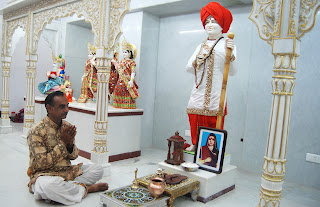A
brand-new structure in Kochi houses the idol of one of the most
revered saints of Gujarat
Photo: Manu R. Mavelil
By
Shevlin Sebastian
On
a sunny Friday morning, a woman and a six-year-old boy steps into the
Jalaram Bapa Dham in Mattancherry, Kochi, and strikes the bell,
hanging from the ceiling. Thereafter, they stand with folded hands in
front of a marble statue of Bapa. He is wearing a red pagadi, a white
muslin kurta, bright red dhoti, and holding a wooden stick in his
hand. The other idols, made from marble obtained from Makrana in
Rajasthan, include Lord Ganesha, Rama, Hanuman, Krishna and Radha.
The canopy is inlaid with 24 carat gold. Meanwhile, the pujari,
Bharat Bhai Pandiya, offers prasadam to the mother and child. And
they step out.
Welcome
to the newest religious structure in Kochi. The three-storey
building, 9000 sq. ft. in area, is gleaming white and is already an
eye-catcher in the area. “It took us three years to make it,”
says Mahesh M. Joshi, Vice President of the Shri Jalaram Dham Trust.
“We started with an initial corpus of just Rs 5 lakh and then the
money just flowed in, all thanks to the blessings of Bapa.”
Jalaram
Bapa is one of the most prominent saints of Gujarat. “There are
Vaishnavs, Jains, Marwaris, Brahmins and Patels who are his ardent
devotees,” says Mahesh. “Undoubtedly, he is not known among
non-Gujaratis.”
Bapa
was born in Virpur, Rajkot district, in 1799. From his teens, he was
engaged in serving pilgrims and sadhus. A devotee of Lord Rama, Bapa
showed no interest in his father's business.
At
the age of sixteen, Jalaram married Virbai. Soon after, he became an
ascetic. Virbai was
also a pious woman and remained steadfast beside her husband. At 18, Bapa became a devotee of Bhoja Bhagat of Fatehpur. With the blessings of his guru, Bapa started 'Sadavrat', a feeding center where sadhus as well as the needy can have food at any time.
also a pious woman and remained steadfast beside her husband. At 18, Bapa became a devotee of Bhoja Bhagat of Fatehpur. With the blessings of his guru, Bapa started 'Sadavrat', a feeding center where sadhus as well as the needy can have food at any time.
Soon,
miracles began taking place. A tailor, Haraji, was suffering from
severe stomach ache. Jalaram prayed to God and Haraji was cured. He
fell at Jalaram's feet and addressed him as Bapa. Since then he began
to be known as Jalaram Bapa. As a result, his fame spread far and
wide, and people came to him with all sorts of problems. Both Hindus
and Muslims became his disciples.
The
main shrine of Bapa is located at Virpur. This is actually the house
where Bapa lived. It contains his belongings, as well as the idols of
Rama, Sita, Lakshman and Hanuman. The singular attraction is the
portrait of Bapa.
In
Virpur, thousands of people are provided meals every day. “We will
be adopting the same practice soon,” says Viren Kalyanji Khona, the
treasurer of the Shri Jalaram Dham Trust. “But, since 1999, we have
been giving food packets to 400 needy families, irrespective of
caste, creed, or religion, on every Thursday, which is regarded as
Guru's Day. We also give buttermilk, during the summer, to thirsty
wayfarers. On an average, 500 glasses are consumed every day.”
Even
for the devotees in Kochi, Bapa does miracles. When there is a
request to Bapa to fulfill a wish, the pujari will take out a red
satin cloth bag, placed in front of Bapa in a small wooden case. This
contains wheat grains. This is placed against the two eyes of the
devotee. Thereafter, the bag is placed near the mouth of Bapa and the
pujari will say, “This person has a desire, please fulfill it.”
And,
inevitably, the promises are fulfilled. “People give donations in
gratitude,” says Viren. “I had a dream of living in my own house
and Bapa has fulfilled it.”
Says
Mahesh, “We are so happy that, finally, we have a dham where we can
worship our Guru, even though we live so far away from Gujarat.”
(The New Indian Express Sunday Magazine, South India and Delhi)

In India, Jalaram Bapa is a very popular religious worker because of his work to enlighten poor and needy people without any discrimination.This statue is made from high quality marble. Buy jalaram bapa statue in india now at low price.
ReplyDeleteThanks for sharing! The sacred ritual of Pind Daan in Sidhpur Matrugaya holds deep spiritual meaning, and with the right pandit, the ceremony can be performed with authenticity and devotion.
ReplyDelete